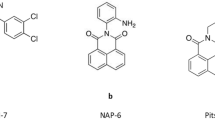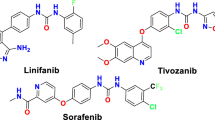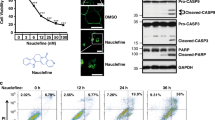Abstract
Indirubin, a bis-indole obtained from various natural sources, is responsible for the reported antileukemia activity of a Chinese Medicinal recipe, Danggui Longhui Wan. However, its molecular mechanism of action is still not well understood. In addition to inhibition of cyclin-dependent kinases and glycogen synthase kinase-3, indirubins have been reported to activate the aryl hydrocarbon receptor (AhR), a cotranscriptional factor. Here, we confirm the interaction of AhR and indirubin using a series of indirubin derivatives and show that their binding modes to AhR and to protein kinases are unrelated. As reported for other AhR ligands, binding of indirubins to AhR leads to its nuclear translocation. Furthermore, the apparent survival of AhR−/− and +/+ cells, as measured by the MTT assay, is equally sensitive to the kinase-inhibiting indirubins. Thus, the cytotoxic effects of indirubins are AhR-independent and more likely to be linked to protein kinase inhibition. In contrast, a dramatic cytostatic effect, as measured by actual cell counts and associated with a sharp G1 phase arrest, is induced by 1-methyl-indirubins, a subfamily of AhR-active but kinase-inactive indirubins. As shown for TCDD (dioxin), this effect appears to be mediated through the AhR-dependent expression of p27KIP1. Altogether these results suggest that AhR activation, rather than kinase inhibition, is responsible for the cytostatic effects of some indirubins. In contrast, kinase inhibition, rather than AhR activation, represents the main mechanism underlying the cytotoxic properties of this class of promising antitumor molecules.
This is a preview of subscription content, access via your institution
Access options
Subscribe to this journal
Receive 50 print issues and online access
$259.00 per year
only $5.18 per issue
Buy this article
- Purchase on Springer Link
- Instant access to full article PDF
Prices may be subject to local taxes which are calculated during checkout








Similar content being viewed by others
Abbreviations
- AhR:
-
aryl hydrocarbon receptor
- ARNT:
-
aryl hydrocarbon receptor nuclear translocator
- bHLH/PAS:
-
basic helix–loop–helix/period-aryl hydrocarbon receptor nuclear translocator-single minded
- BIO:
-
6-bromo-indirubin-3′-oxime
- BSA:
-
bovine serum albumin
- CDK:
-
cyclin-dependent kinase
- DAPI:
-
diaminophenylindole, dihydrochloride
- DTT:
-
dithiothreitol
- EGFP:
-
enhanced green fluorescent protein
- FCS:
-
fetal calf serum
- FICZ:
-
6-formylindolo[3,2-b]carbazole
- GSK-3:
-
glycogen synthase kinase -3
- IO:
-
indirubin-3′-oxime
- MeBIO:
-
1-methyl-6-bromo-indirubin-3′-oxime
- MeIO:
-
1-methyl-indirubin-3′-oxime
- MTT:
-
(4,5-dimethylthiazol-2-yl)-2,5-diphenyltetrazolium-bromide
- TCDD:
-
2,3,7,8-tetrachlorodibenzo-p-dioxin
- XRE:
-
xenobiotic-responsive element
References
Adachi J, Mori Y, Matsui S, Takigami H, Fujino J, Kitagawa H, Miller III CA, Kato T, Saeki K and Matsuda T . (2001). J. Biol. Chem., 276, 31475–31478.
Andersson P, McGuire J, Rubio C, Gradin K, Whitelaw ML, Pettersson S, Hanberg A and Poellinger L . (2002). Proc. Natl. Acad. Sci. USA, 99, 9990–9995.
Abdelrahim M, Smith III R and Safe S . (2003). Mol. Pharmacol., 63, 1373–1381.
Bain J, McLauchlan H, Elliott M and Cohen P . (2003). Biochem. J., 371, 199–204.
Balfour-Paul J . (1998). Indigo. British Museum Press: London, UK, 264pp.
Bergander L, Wahlstrom N, Alsberg T, Bergman J, Rannug A and Rannug U . (2003). Drug Metab. Dispos., 31, 233–241.
Borgne A and Meijer L . (1996). J. Biol. Chem., 271, 27847–27854.
Bradshaw TD, Trapani V, Vasselin DA and Westwell AD . (2002). Curr. Pharm. Design, 8, 2475–2490.
Chotani G, Dodge T, Hsu A, Kumar M, LaDuca R, Trimbur D, Weyler W and Sanford K . (2000). Biochim. Biophys. Acta, 1543, 434–455.
Cooksey CJ . (2001). Molecules, 6, 736–769.
Damiens E, Baratte B, Marie D, Eisenbrand G and Meijer L . (2001). Oncogene, 20, 3786–3797.
Davies TG, Tunnah P, Meijer L, Marko D, Eisenbrand G, Endicott JA and Noble MEM . (2001). Structure, 9, 389–397.
Dealler SF, Hawkey PM and Millar MR . (1988). J. Clin. Microbiol., 26, 2152–2156.
Denison MS, Phelen D and Elferink CJ . (1998). Xenobiotics, Receptors and Gene Expression. Denison MS and Helferich W (eds). Taylor & Francis: Philadelphia, PA, pp. 3–33.
Denison MS and Nagy SR . (2003). Annu. Rev. Pharmacol. Toxicol., 43, 309–334.
Elbi C, Misteli T and Hager GL . (2002). Mol. Biol. Cell, 13, 2001–2015.
Elferink CJ . (2003). Cell cycle regulators as therapeutic targets. Meijer L, Jezequel A and Roberge M (eds). Progr. Cell Cycle Res., 5, 261–267.
Elferink CJ, Ge NL and Levine A . (2001). Mol. Pharmacol., 59, 664–673.
Fernandez-Salguero P, Pineau T, Hilbert DM, McPhail T, Lee SS, Kimura S, Nebert D, Rudikoff S, Ward JM and Gonzalez FJ . (1995). Science, 268, 722–726.
Ffrench M, Bryon PA, Fière D, Vu Van H, Gentilhomme O, Adeleine P and Viala J-J . (1985). Cytometry, 6, 47–53.
Fukunaga BN, Probst MR, Reisz-Porszasz S and Hankinson O . (1995). J. Biol. Chem., 270, 29270–29278.
Ge NL and Elferink CJ . (1998). J. Biol. Chem., 273, 22708–22713.
Gillam EMJ, Notley LM, Cai H, DeVoss JJ and Guengerich FP . (2000). Biochemistry, 39, 13817–13824.
Guthrie C and Fink GR . (1991). Guide to Yeast Genetics and Molecular Biology, Abelson JN and Simon MI (eds). Academic Press Inc.: San Diego, CA, USA.
Hahn ME . (2002). Chem.-Biol. Interact., 141, 131–160.
Hankinson O . (1995). Annu. Rev. Pharmacol. Toxicol., 35, 307–340.
Hayashibara T, Yamada Y, Mori N, Harasawa H, Sugahara K, Miyanishi T, Kamihira S and Tomonaga M . (2003). Biochem. Biophys. Res. Commun., 300, 128–134.
Heath-Pagliuso Rogers WJ, Tullis K, Seidel SD, Cenijn PH, Brouwer A and Denison M . (1998). Biochemistry, 37, 11508–11515.
Hoessel R, Leclerc S, Endicott J, Noble M, Lawrie A, Tunnah P, Leost M, Damiens E, Marie D, Marko D, Niederberger E, Tang W, Eisenbrand G and Meijer L . (1999). Nat. Cell Biol., 1, 60–67.
Jacobs MN, Dickins M and Lewis DF . (2003). J. Steroid Biochem. Mol. Biol., 84, 117–132.
Jain S, Maltepe E, Lu MM, Simon C and Bradfield CA . (1998). Mech. Dev., 73, 117–123.
Joiakim A, Mathieu PA, Palermo C, Gasiewicz TA and Reiners JJ . (2003). Drug Metab. Dispos., 31, 1279–1282.
Kawanishi M, Sakamoto M, Ito A, Kishi K and Yagi T . (2003). Mutat. Res., 540, 99–105.
Knockaert M, Greengard P and Meijer L . (2002). Trends Pharmacol. Sci., 23, 417–425.
Koliopanos A, Kleeff J, Xiao Y, Safe S, Zimmermann A, Buchler MW and Friess H . (2002). Oncogene, 21, 6059–6070.
Kolluri SK, Weiss C, Koff A and Göttlicher M . (1999). Genes Dev., 13, 1742–1753.
Kolluri SK, Balduf C, Hofmann M and Göttlicher M . (2001). Cancer Res., 61, 8534–8539.
Kuchenhoff A, Seliger G, Klonisch T, Tscheudschilsuren G, Kaltwasser P, Seliger E, Buchmann J and Fischer B . (1999). Fertil. Steril., 71, 354–360.
Kuramoto N, Baba K, Gion K, Sugiyama C, Taniura H and Yoneda Y . (2003). J. Neurochem., 85, 264–273.
Lahvis GP, Lindell SL, Thomas RS, McCuskey RS, Murphy C, Glover E, Bentz M, Southard J and Bradfield CA . (2000). Proc. Natl. Acad. Sci. USA, 97, 10442–10447.
Leclerc S, Garnier M, Hoessel R, Marko D, Bibb JA, Snyder GL, Greengard P, Biernat J, Mandelkow E-M, Eisenbrand G and Meijer L . (2001). J. Biol. Chem., 276, 251–260.
Ma Q and Whitlock JP . (1996). Mol. Cell. Biol., 16, 2144–2150.
MacNeil IA, Tiong CL, Minor C, August PR, Grossman TH, Loiacono KA, Lynch BA, Phillips T, Narula S, Sundaramoorthi R, Tyler A, Aldredge T, Long H, Gilman M, Holt D and Osburne MS . (2001). J. Mol. Microbiol. Biotechnol., 3, 301–308.
Marko D, Schätzle S, Friedel A, Genzlinger A, Zankl H, Meijer L and Eisenbrand G . (2001). Br. J. Cancer, 84, 283–289.
Maugard T, Enaud E, Choisy P and Legoy MD . (2001). Phytochemistry, 58, 897–904.
Meijer L, Skaltsounis AL, Magiatis P, Polychronopoulos P, Knockaert M, Leost M, Ryan XP, Vonica CD, Brivanlou A, Dajani R, Tarricone A, Musacchio A, Roe SM, Pearl L and Greengard P . (2003). Chem. Biol., 10, 1255–1266.
Miller CA . (1997). J. Biol. Chem., 272, 32824–32829.
Miller CA . (1999). Toxicol. Appl. Pharmacol., 160, 297–303.
Mosmann J . (1983). Immunol. Methods, 65, 55–63.
Nagy SR, Sanborn JR, Hammock BD and Denison MS . (2002a). Toxicol. Sci., 65, 200–210.
Nagy SR, Liu G, Lam KS and Denison MS . (2002b). Biochemistry, 41, 861–868.
Peters WL and Wiley D . (1995). Toxicol. Appl. Pharmacol., 13, 214–221.
Petersen SL, Curran MA, Marconi SA, Carpenter CD, Lubbers LS and McAbee MD . (2000). J. Comp. Neurol., 427, 428–439.
Polychronopoulos P, Magiatis P, Skaltsounis L, Myrianthopoulos V, Mikros E, Tarricone A, Musacchio A, Roe SM, Pearl L, Leost M, Greengard P and Meijer L . (2004). J. Med. Chem., 47, 935–946.
Primot A, Baratte B, Gompel M, Borgne A, Liabeuf S, Romette JL, Costantini F and Meijer L . (2000). Protein Expr. Purif., 20, 394–404.
Procopio M, Lahm A, Tramontano A, Bonati L and Pitea D . (2002). Eur. J. Biochem., 269, 13–18.
Rannug U, Bramstedt H and Nilsson U . (1992). Mutat. Res., 282, 219–225.
Rowlands JG and Gustafsson JA . (1997). Crit. Rev. Toxicol., 27, 109–134.
Safe S . (2001). Toxicol. Lett., 120, 1–7.
Safe S and McDougal A . (2002). Int. J. Oncol., 20, 1123–1128.
Salomon-Nguyen F, Della-Valle V, Mauchauffe M, Busson-Le Coniat M, Ghysdael J, Berger R and Bernard OA . (2000). Proc. Natl. Acad. Sci. USA, 97, 6757–6762.
Santini RP, Myrand S, Elferink C and Reiners JJ . (2001). J. Pharmacol. Exp. Ther., 299, 718–728.
Schmidt JV, Su GH, Reddy JK, Simon MC and Bradfield CA . (1996). Proc. Natl. Acad. Sci. USA, 93, 6731–6736.
Shimizu Y, Nakatsuru Y, Ichinose M, Takahashi Y, Kume H, Mimura J, Fujii-Kuriyama Y and Ishikawa T . (2000). Proc. Natl. Acad. Sci. USA, 97, 779–782.
Song J, Clagett-Dame M, Peterson RE, Hahn ME, Westler WM, Sicinski RR and DeLuca HF . (2002). Proc. Natl. Acad. Sci. USA, 99, 14694–14699.
Spink BC, Hussain HM, Katz BH, Eisele L and Spink DC . (2003). Biochem. Pharmacol., 66, 2313–2321.
Tang W and Eisenbrand G . (1992). Chinese Drugs of Plant Origin, Chemistry, Pharmacology, and Use in Traditional and Modern Medicine. Springer-Verlag: Heidelberg.
Wei YD, Bergander L, Rannug U and Rannug A . (2000). Arch. Biochem. Biophys., 383, 99–107.
Weiss C, Kolluri SK, Kiefer F and Göttlicher M . (1996). Exp. Cell Res., 226, 154–163.
Wolff S, Harper PA, Wong JM, Mostert V, Wang Y and Abel J . (2001). Mol. Pharmacol., 59, 716–724.
Xiao Z, Hao Y, Liu B and Qian L . (2002). Leukemia Lymphoma, 43, 1763–1768.
Yoon BI, Hirabayashi Y, Kawasaki Y, Kodama Y, Kaneko T, Kanno J, Kim DY, Fujii-Kuriyama Y and Inoue T . (2002). Toxicol. Sci., 70, 150–156.
Acknowledgements
We are most thankful to our colleagues for providing reagents: Dr Gerhard Eisenbrand (compounds 3, 5, 6, 7, 8, 9, 19, 21, 22), Dr Martin Göttlicher (5L and BP8 cell lines), Dr Charles A Miller III (AhR agonists reporter yeast strain), and Dr Steve Safe (TCDD). This research was also supported by grants from the ‘Association pour la Recherche sur le Cancer’ ARC5732 (LM), ARC5812 (MB) and ARC5664 (MF), the National Institutes of Environmental Health Sciences NIH5P42ES04699 (MD) and by a grant (‘Molécules & Cibles Thérapeutiques’) from the ‘Ministère de la Recherche/INSERM/CNRS’ (LM).
Author information
Authors and Affiliations
Corresponding author
Rights and permissions
About this article
Cite this article
Knockaert, M., Blondel, M., Bach, S. et al. Independent actions on cyclin-dependent kinases and aryl hydrocarbon receptor mediate the antiproliferative effects of indirubins. Oncogene 23, 4400–4412 (2004). https://doi.org/10.1038/sj.onc.1207535
Received:
Revised:
Accepted:
Published:
Issue Date:
DOI: https://doi.org/10.1038/sj.onc.1207535
Keywords
This article is cited by
-
Synergistic effect of plasma-activated medium and novel indirubin derivatives on human skin cancer cells by activation of the AhR pathway
Scientific Reports (2022)
-
Indirubin inhibits the migration, invasion, and activation of fibroblast-like synoviocytes from rheumatoid arthritis patients
Inflammation Research (2017)
-
Identification of small molecules that support human leukemia stem cell activity ex vivo
Nature Methods (2014)
-
A novel role of the aryl hydrocarbon receptor (AhR) in centrosome amplification - implications for chemoprevention
Molecular Cancer (2010)
-
Untangling tau hyperphosphorylation in drug design for neurodegenerative diseases
Nature Reviews Drug Discovery (2007)



